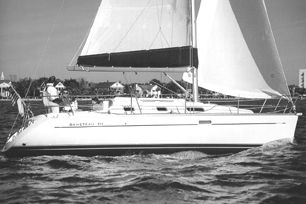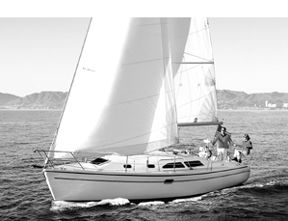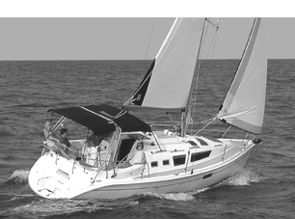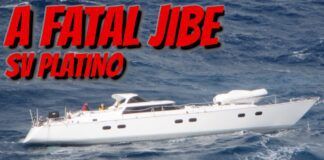
In an ideal world, all sailors would start in prams at the age of six, then move to small, forgiving sloops, and then one-design racing boats, and then bigger cruising boats. But that’s rarely the way it works. In recent years there have been a considerable number of people able to proceed directly to “Go” and skip the early parts. This was a concept that stumped us while we looked for a way to compare “entry-level” cruising boats from the big boatbuilders. Obviously, people can enter cruising at any level, whether in a 50-footer, a trailer-sailer, or a battered old Rhodes 19 with a blue tarp and a cooler.
After surveying manufacturers, dealers, and owners, and considering the demographics of the sailing community and the profile of newcomers to the sport, we settled on a definition of “entry-level cruising boat” that would at least let us get our arms around an article. How about this: “a boat that lives in the water on a mooring or in a slip, and that has space on deck and below in which, say, four people can relax, eat, sleep, and travel in protected waters for a few days in decent comfort.”
We chose the Beneteau 311, Catalina 310, and Hunter 326. They seemed to match well in terms of size, sail area, ease of operation, accommodations, and price. Dimensions are comparable, as are working spaces on the deck, the type and arrangement of gear, cockpit size, and space and furnishings below. All are equipped with a suit of sails and headsail furlers. Sure, Catalina builds a 30-footer, and the 320 that could possibly have been included. Hunter has a recently introduced 306, a twice-stretched version of the Hunter 28… and so on. But this is a batch of oranges worthy of comparison. Depending upon options added, shipping, and commissioning, the range is $70,000-$80,000 for a new boat in this market. Competitive pricing makes these boats worth a close look when compared to used boats in the same size range.
An interesting aside: We learned in talking with builders and dealers that they know their market, including personality types, and the likely use of the boats. By their accounts, Catalina owners are more likely to sail, and work on, their boats; Hunter owners are more likely to use the boats for dockside entertainment, and reach for a credit card when repairs are to be made. Beneteau owners seem to fall somewhere in between.
The Companies
Beneteau, Catalina, and Hunter are the equivalent of the Big Three auto makers—they produce the vast majority of sailboats sold worldwide. Beneteau is the largest producer in the world. Hunter, the largest in the USA, also has a European production facility. Catalina Yachts has become the second-largest builder in the US, and has an international distribution system. More than 70,000 Catalina sailboats have been built.
Design
All three hulls have fuller, rounder shapes than production cruising designs of even a few years ago, and they’re a lot tubbier than traditional sloops. The type of design usually produces a big interior volume that maximizes the physical comfort of the crew dockside, usually at the expense of stowage space for the contents of duffle bags, and for boat gear.
Like many Beneteau models, the 311 was designed by Group Finot in France. She has a plumb bow, reverse transom, rounded bilges, and sloping cabintop. Mike Thoney of Beneteau USA describes the boat as being “designed to be easy to handle as a fast, contemporary, performance cruiser. The target market for the boat is younger families, and older sailors moving to smaller boats.”
The Beneteau plant in South Carolina has built 120 of the 311s since it was introduced in 1998.
Hunter’s 326 was introduced in May, 2001, and more than 100 have been delivered in the US since then. Like most Hunters built since the mid-’90s, it’s characterized by high freeboard, a round cabin, and a rounded stern accentuated by a rubrail that covers the hull-deck joint. A stainless steel arch over the cockpit to bear the mainsail controls is now a standard feature.
Glenn Henderson, chief naval architect and director of engineering for Hunter, says “the 326 buyer probably had a 24-26 footer, so this is his first boat that needs a slip. It can be comfortably used for coastal cruising, is more forgiving than older models, and has more responsive steering.”
Many readers will know Henderson for the fast sailboats he’s designed under his own name. It’s no surprise when he says, “We’re placing increased emphasis on the performance aspects of all of our boats, within the constraints of our owner group. Performance doesn’t just equate to speed, because our owners are family cruiser groups. We consider safety a performance criterion. Positive stability is a major concern. We know that our boats are used for entertainment purposes, but still design every boat to withstand the treatment given by more serious sailors. The 326 hull features a moderately full forward section designed to accommodate crew and stores without affecting trim. She was designed as a Category B boat for CE certification.”
The Catalina 310 is the most traditional-looking of the three, with a moderate overhang on the bow, high-aspect mainsail, and rounded stern. Standard headsail is a 135-percent genoa, but a 155-percent sail is an option.
“The boat was introduced in 1999, and we’ve built 212,” says Gerry Douglas, vice president and chief designer at Catalina. “The design started with the 320 six years ago. She has a fine forward entry, flat aft section, and narrow waterline beam. She’s rounded amidships to provide weight for load carrying without changing the trim.”
Compared to the others, the most significant difference is Catalina’s intent to make this boat a generous cruiser for two people, not a cramped cruiser for four. The forward stateroom is bigger and the berth easier to access than the others. The trade-off is that the aft sleeping area is wide-open, enclosed by a curtain.
“We think it’s a radical departure from most small boats. We wanted a small boat with big-boat feeling, like our 38 without all of the extra furniture,” Douglas says. “It’s not worth trying to enclose the aft area because that would shorten the saloon. This is a ‘drink eight, feed four, sleep two boat,’ with a long cockpit for sleeping outdoors.”
It’s this kind of definitive builder’s statement that serves boatbuyers best—prospective buyers know immediately whether this boat will work for them, at least in its overall purpose. Douglas may lose a few at the outset, but it’s a much better approach than one that promises everything vaguely.
Deck and Cockpit
Three criteria apply in evaluating cockpits: the ease with which the helmsman and crew can operate the boat, crew comfort, and stowage. The size and accessibility of swim platforms and other accessories are separate considerations.
The rounded shape of the Hunter cockpit is described by owners as being “like a bathtub” compared to the more conventional shapes of the others. The Beneteau and Catalina carry the beam farther aft to a wider section at the stern, which makes for more comfortable seating space than in the 326’s stern quarter.
All are equipped with 32-inch stainless steel wheels large enough for steering while standing or seated amidships. However, the wheels are too small to allow driving from the rail. The Whitlock rack and pinion steering on the Hunter is an unusual touch, and seemed more responsive than the cable steering on the others.
All three boats are equipped with steering pedestals that house instruments and tables. The tables on the Beneteau and Catalina fold out of the way in front of the pod; the Hunter has 17″ long leaves on the side of an equally long pedestal. Though the pedestal has a built-in cooler, the design inhibits movement when the table is raised. All three have adequate space behind the wheel to steer comfortably; however, space between the pedestal and companionway on the Hunter is only 24″, compared to 36″-39″ inches on the others. The result is a cramped space for passengers near the companionway.
Conversely, the 43″ between seats on the Catalina is criticized as being too wide by owners who say the cockpit sole needs a footrest. “The first boats had one,” says Gerry Douglas, “but we removed it because owners said it was a toe-stubber.”
Owners. Can’t live with ’em… Let’s put it this way: If you want to actually sail the boat, you should spend a Saturday morning adding a teak strip to the sole; otherwise, passengers will be tempted to move aft and huddle with feet braced against the pedestal.
All three have 78-80″ long seats that allow a six-footer to stretch out for a snooze, and backrests 11-13″ high that provide lumbar support.
Storage on the Beneteau is in lockers running the length of the seats on both sides of the cockpit. These are large enough for dock lines and accessories, and an inflatable dinghy. The Hunter and Catalina have a hatch under one seat for use as an emergency exit for passengers in the aft compartment. That compromises the storage area; the Hunter partially offsets the loss by adding two storage compartments on the swim platform.
Rigging and Gear
The Beneteau has a single-spreader 7/8 rig; the Catalina has a double-spreader masthead rig. The Hunter’s mast is set in a double-spreader B&R configuration: Spreaders are swept aft and there’s no backstay. Shrouds are arranged in a diamond pattern; one set terminates on the rail, the other on the cabintop. Hunter claims that this arrangement allows the use of smaller mast sections, with a reduction of weight aloft, plus the use of full-roach mainsails.

Mainsail controls are mounted on a stainless steel arch over the cockpit. Appearance aside, there are a couple of arguments in favor of this arrangement: It keeps the mainsheet tackle and traveler out of the cockpit, and it allows the sheet to terminate at the end of the boom, a plus for sail shape control. The sheet is led from the end of the boom forward to the mast and then aft again to the cockpit. Harken traveler track and cleats are located on the arch; traveler control lines terminate near the helmsman’s fingertips. However, the traveler arrangement, as it turns out, is a $593 option that’s standard on the other boats. This may reflect the sailing proclivities of the target market.
A major disadvantage of the arch is that, absent a mainsail flaking system, you’ll need someone from the Chicago Bulls to get the sail settled on the aft end of the boom.
The Hunter’s competitors have more traditional stayed rigs. The Beneteau’s shrouds terminate on deck, the Catalina’s on the cabintop. Both have decks 16-18″ wide, and handrails, so movement forward when heeled in unimpeded.
Mainsail controls on the Beneteau and Catalina are forward of the companionway because few cruisers want the hardware to interfere with creature comfort. Both are equipped with a solid vang, however, which improves sail shape and performance.
Catalina wins the winch competition by installing four Lewmar winches as standard equipment. In comparison, the Hunter is equipped with two Lewmar self-tailers on the coachroof; coamings are pre-molded to house optional primaries. The Beneteau is equipped with three, but we doubt many owners will decline to purchase the optional fourth.
All three boats offer easy sailhandling capabilities, with halyards and sheets led to the cockpit. The Hunter offers better sail-shaping capabilities but, as one Hunter owner said, “that arch still reminds me of a Bayliner.”
Belowdecks
Since we’re evaluating boats that are 32 feet long on deck, we don’t expect enough room below to host a reception for the Queen.
Saloons: The Hunter’s saloon, the largest of the three, is 128″ long from the bottom of the companionway step to the bulkhead, and 90″ wide from the settee backs. Any space created in the saloon has to come from somewhere. In this case, it’s the cockpit.
All three boats have enough hatches on deck, and fixed and opening ports, to allow light and fresh air to flow freely, even in the heads and aft staterooms.
Light wood and white headliners on the Hunter and Catalina produce brighter spaces. Interestingly, Hunter now installs a “Whisper Soft” headliner that has removed 120 pounds from the overhead, “most of it putty,” says Glenn Henderson. The new liner is easily removed and replaced.
Despite the boats’ mid-range prices, all of the builders are improving the fit and finish of joinery. Hunter’s use of computers to cut wood sections produces a dramatic improvement over 10-year-old boats—enough to begin to rival Beneteau, the best finished of the bunch.
The primary difference between the layout of interior spaces is that the Catalina, as Gerry Douglas readily explains, is not designed to be the host boat at a rendezvous; the others are more likely candidates.
The Catalina features a pedestal table arrangement that allows a ‘cocktail table’ measuring 16×22″ to be converted to a dining table by placing a portable tabletop on the smaller unit. The 30-lb top is stored out of the way in the aft compartment. However, as one owner told us, “it’s cumbersome, and one of the only disadvantages of this boat.”
With 12-14″ more space amidships between the settee backs, the Catalina has more lounging space. Neither the dining area or settee to starboard are intended to be used as bunks, though.
In contrast, the Beneteau and Hunter have tables located amidships that, with leaves open, allow for comfortable dining by 4-6 adults. Six-foot-long settees port and starboard provide comfortable seating and additional berths.
Galleys: Seacooks will be more impressed with the workstation in the Catalina or the Hunter than the Beneteau. All galleys are equipped with stainless steel sinks and double-burner stoves. However, counter space in the Beneteau is a flat surface measuring 18×20″. The largest, the Hunter, has a C- shaped galley with a counter on the aft bulkhead measuring 21×36″, and an L-shaped work area at the sink.
Nav stations: as one builder told us, “navigation stations on this size boat are almost unnecessary since most instruments will be mounted on the pedestal, or be portable.” The Catalina has a small chart table aft of the stove, with seating on the aft bunk. The Hunter’s chart table has aft-facing seating on the port settee. However, instruments on the bulkhead must be surface-mounted or they’ll be exposed in the head. The Beneteau’s chart table houses a refrigerator, so has no legroom.
Sleeping accommodations: On the Hunter and Beneteau, overnight sleeping accommodations are in enclosed staterooms fore and aft. The Beneteau’s are more spacious: Aft to port, the skipper’s quarters house a berth wide enough to allow two to sleep fore and aft, leaving space below the cockpit for storage on the other side. Three ports, one on the stern, and reading lights provide ventilation and illumination. The berth in the forward stateroom is 80″ long, and 50″ wide at the shoulder.
Hunter’s aft stateroom offers room in which to dress with 6′ of headroom at its entrance, next to a large hanging locker. A queen-sized berth is oriented athwartships. The berth is only 4″ above the cabin sole, significantly increasing space overhead compared to many aft staterooms. The forward stateroom pays for the extra space in the main saloon. With only 5’5″ of headroom, the V-berth is 6’5″ long with an insert in place, but abuts the forward bulkhead, leaving no room to stand when the insert is in place.
The Catalina has the best stateroom of the lot, a queen-sized berth on an island in the bow with 24″ of clearance between bulkhead and berth. The aft sleeping compartment is large enough for children or one adult.
Heads: The Catalina’s head gets the nod. It’s larger, and has a shower separated by a hanging curtain. An 18×15″ mirror covers a deep medicine cabinet. Cleaning supplies can be stored under the sink.
So, in a nutshell, the Beneteau and Hunter offer more living and sleeping areas; the Catalina will more comfortably accommodate a couple or a family with small children. The Hunter and Catalina have larger galleys; the Hunter and Beneteau the better nav stations.
Construction
The construction methods used in these boats bear a striking resemblance to each other—a reflection of the degree to which the industry is becoming standardized. All three companies follow techniques that allow the mass production of lower-priced boats by combining the most efficient use of labor with volume purchases of raw materials. They generally buy most raw materials and equipment from the same suppliers, and use many of the same computer models. The differences these days are primarily in the execution of the layup schedule.

In effect, the companies construct a hull into which a grid-and-beam system is installed, along with liners (pans) that define spaces belowdecks and provide furniture bases. Similarly, decks are molded and laid over flanges, to which they are bonded and through-bolted. A rubrail or toerail typically conceals the hull-deck joints.
In the past, these methods often produced ill-fitting bulkheads and squeaky cabinetry. More recently, accurately molded components and improvements in bonding material have significantly reduced those problems.
Common denominators are the use of vinylester resins to prevent osmotic blistering, 3M 5200 (or, in the case of Beneteau, “3M-like materials”) to bond hull-deck joints; various combinations of mat and roving, and deck gear solidly attached to backing plates.
Hunter lays up hulls using “Hunter Kevlar Technology.” Glenn Henderson says there’s a lamination of four layers of hybrid E-glass and Kevlar in high-impact areas from the forward edge of the keel to the stem. The hull is solid fiberglass under the waterline; above the waterline topsides are laid up with a combination of Coremat and Baltek end-grain balsa. Decks are laid up with woven roving and cored with marine-grade plywood. Aluminum backing plates are laminated into the deck where hardware will be mounted, and winches are through-bolted. Plywood is used under low-load halyard and sheet organizers.
Gerry Douglas says the layup of the Catalina 310 mirrors that of the company’s predecessor 320: The hull is solid fiberglass with a double thickness on the centerline. The deck is cored with plywood, and the cabintop with end-grain balsa.
Catalina has been installing aluminum backing plates in the layup to provide a solid base for deck hardware for several years. Hardware is installed in tapped holes to ease removal for maintenance, prevent deck leaks, and eliminate dimples in the headliner. These are certainly good features, but we’d like to express the same concerns we did last month in our review of the Cabo Rico 38, which uses a similar system, but in stainless steel: If the threads in these plates are stripped, or if stress fractures develop in the surrounding glass, it will bring on a major headache.
The largest manufacturer of sailboats in the world, Beneteau has mastered the art of reducing labor and material costs while moving boats quickly down the production line. Like those of its many sisters, the 311’s hull is solid fiberglass reinforced by an internal grid system of beams and stringers. A monocoque approach is taken to the installation of bulkheads, which are bonded 360 degrees to the hull and deck.
The deck is cored with balsa for stiffness, and a liner provides additional stiffness, insulation, and facilitates maintenance.
All three of these boats are constructed to meet CE Standard B, the designation for coastal cruisers in Europe.
Options
Like their counterparts in the automobile industry, boat manufacturers are learning that adding options to the base boat has its advantages. It removes many purchase decisions. (What kind of microwave, honey?) It adds high profit-margin items to the purchase price. And it helps eliminate problems created by aftermarket installations.
There are some significant differences: Catalina and Beneteau both provide refrigeration as standard equipment; Hunter does not. Hunter includes a Raymarine VHF radio/knotmeter/depthsounder package, the only instrumentation that’s standard on the three. However, Hunter charges for the mainsheet traveler ($593), and primary winches (Lewmars, for $990). Catalina, much to its credit, includes four winches as standard gear.
Performance
We sailed all three boats, but it would be unfair to base a performance comparison on our tests. The Catalina had a full-cut main; the others mainsail furlers that reduce sail area by 17-20%. Headsails were different sizes. One boat was loaded to the gunwales, another stripped bare. One bottom hadn’t been cleaned in a year.
However, we did form some opinions: All three sail well in light air, and can tack within 80-90°. Their helms are well-balanced. The Hunter is the tenderest, especially in moderate puffs. She would benefit from a built-in foot brace, since steering while heeled and sitting isn’t comfortable.
We sailed the deep-draft versions of all these boats: They all forged ahead nicely after some initial heeling in puffs. Presumably they would lose some lift and develop more leeway in their shoal-draft configurations.
All will exceed 6 knots on a reach in 12-15 knots of wind, but we wouldn’t call any of them fast. Performance suffers especially when sailing below a broad reach, when small headsails are blanketed by the main. We can’t imagine owning one of these boats without a light-air drifter.
Based on numbers alone, they should perform to within 10-15% of the each other. Though the Beneteau is 30% lighter than the Catalina, the latter boat did well in light air, and will probably be more comfortable, and drier, in a blow or steep seas. The SA/D and D/L indicate that the Beneteau and Hunter are faster, but these numbers ignore the positive aspects of a good hull shape, and we think the Catalina loses nothing here.
Conclusion
All the builders have maximized the use of space, albeit in different ways. Construction methods are similar. They are nicely appointed, if not well-equipped. Deck hardware is laid out and sized properly for typical inshore sailing conditions. The engines, too, seem properly sized; we motored at 5-6 knots easily with little noise below.
There’s no way to pin down which of these boats is the “best.” Any of them will meet the needs of “entry-level” sailors, according to the definition we made early in the article, and it really comes down to what shape pleases you, what minor variations in accommodations suit you best, and how you like the feel of the boat when sailing it.
The Beneteau is arguably the best-finished of the lot. It’s also the least expensive and, on paper, the fastest. The Hunter has more innovative design features (including the arch), and a good layout below for a quiet getaway. If we had to pick one ourselves, though, we’d go with the Catalina, despite the weight and the extra expense. We like the hull form and the familiar sailing characteristics. We also favor the “open floorplan” on a boat this size—privacy isn’t as important as air and traffic flow. The 310 is likely to prove the most comfortable for a combination of family life and sailing.
Contact – Beneteau USA, 24 North Market St., Suite 201, Charleston, SC 29401; 843/805-5000; www.beneteauusa.com. Catalina Yachts, 21200 Victory Blvd., Woodland Hills, CA 91367;818/884-7700; www.catalinayachts.com. Hunter Marine, Route 441, PO Box 1030, Alachua, FL 32615; 386/462-3077; www.huntermarine.com.
Also With This Article
Click here to view “Specifications.”
Click here to view boat drawings.







































